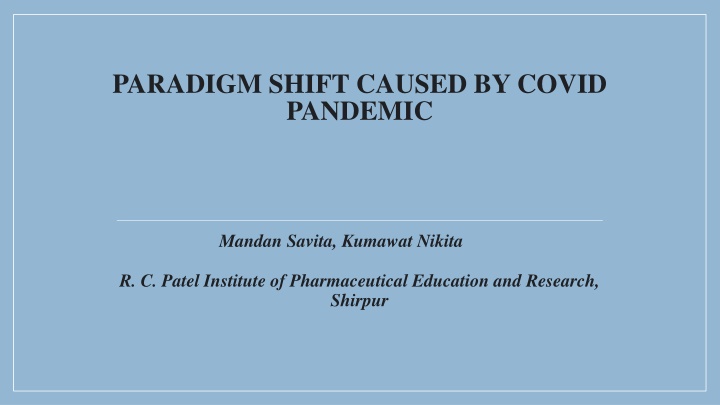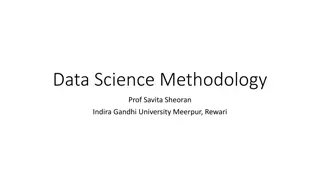
Impacts of COVID-19 Paradigm Shift on Education, Market, and Trade
Explore the paradigm shift caused by the COVID-19 pandemic, impacting various sectors like education, market, and trade. Discover the challenges faced and changes implemented due to this global health crisis, affecting public health care and economic systems worldwide.
Download Presentation

Please find below an Image/Link to download the presentation.
The content on the website is provided AS IS for your information and personal use only. It may not be sold, licensed, or shared on other websites without obtaining consent from the author. If you encounter any issues during the download, it is possible that the publisher has removed the file from their server.
You are allowed to download the files provided on this website for personal or commercial use, subject to the condition that they are used lawfully. All files are the property of their respective owners.
The content on the website is provided AS IS for your information and personal use only. It may not be sold, licensed, or shared on other websites without obtaining consent from the author.
E N D
Presentation Transcript
PARADIGM SHIFT CAUSED BY COVID PANDEMIC Mandan Savita, Kumawat Nikita R. C. Patel Institute of Pharmaceutical Education and Research, Shirpur
Introduction The coronavirus pandemic was widely thought to be the biggest worldwide health crisis of the 20th century. The newer respiratory illness (SARS-CoV-2) first arrived in city of China (Wuhan). Older people and those with underlying medical conditions like cardiovascular disease, diabetes, chronic respiratory disease, or cancer are more likely to develop serious illness. Anyone can get sick with COVID-19 and become seriously ill or die at any age.
THE IMPACT OF THE COVID-19 ON THE PUBLIC HEALTH CARE SYSTEM This pandemic has resulted in both short- and long-term health issues, such as mental stress, elevated anxiety, and post-traumatic stress disorder (COVID-19) . The economic and social disruption caused by the pandemic is devastating tens of millions of people are at risk of falling into extreme poverty, while the number of undernourished people. COVID-19 has created serious financial and health burdens. Over the past two years, the world has seen a shift in behaviors, the economy, medicine and beyond due to the COVID-19 pandemic
PARADIGM FACTORS 1.Education 2.Market 3. Trade 4. Economy
Education Many schools, universities, and other higher education institutions no longer offer in-person education training. It is vital to implement novel and creative teaching and evaluation strategies. We now have the opportunity to prepare for the arrival of digital learning. Number of issues, including knowledge barriers, poor learning environments at home, equity issues, and academic success in higher learning. break.
Market The impact of COVID-19 on the world market has been significant: Stock markets, foreign exchange markets, bond markets, etc. are a few examples. It is one of the industries that has been most severely impacted by changes in the price of oil on the worldwide market. Due to this, the value of financial assets has decreased, which has affected currency exchange rates as well. There have been disruptions to stock markets worldwide, including those in New York, Frankfurt, Tokyo, and London. For a number of businesses, the supply chain collapse has resulted in cash flow issues.
3. Trade The declines in both world industrial production and goods trade in the first half of 2020 were of similar depth to those at the trough of the Global Financial Crisis. Trade continued to grow strongly in 2021 and has compensated some, but not all, of the accumulated losses from the steep declines seen earlier. Trade in digitally delivered services, such as telecommunication and information technology services, boomed. Some international supply chains came under pressure in the early months of the pandemic due to extraordinary demand. The 8% gap in global merchandise trade volumes that unfolded in May 2020 was significantly reduced in late 2020 and throughout 2021.
4. Economy Pandemics can also result in declined tax revenues and increased expenditure, which causes fiscal stress, especially in lower-middle-income countries. Economic shocks are common during pandemics due to shortage of labor because of illness, rise in mortality, and a fear-induced behavior. Other than labor shortages, disruption of transportation, closed down of workplaces, restricted trade and travel, and closed land border are reasons for the pandemic's economic slowdown. Major events included the collapse of crude oil prices and a stock market crash in March 2020.
Conclusion As the world looks to a future in which COVID-19 has been brought under control, and as technology penetrates even further every aspect of our lives, the pandemic has helped to shed light on the importance of developing and implementing effective policies based on human-centric values that protect the rights of individuals but also work towards a collective good.
Reference Ando, M., & Hayakawa, K. (2022). Impact of COVID-19 on trade in services. Japan and the World Economy, 62. https://doi.org/10.1016/j.japwor.2022.101131 Asad Ullah, M., Araf, Y., Sarkar, B., Tayeb Moin, A., al Islam Reshad, R., & Rahman, H. (2020). Pathogenesis, Diagnosis and Possible https://doi.org/10.20944/preprints202004.0372.v1 COVID-19. Therapeutic Options for Baldwin, R. E., Weder, Beatrice., & Centre for Economic Policy Research (Great Britain). (2020a). Economics in the time of COVID-19. CEPR Press. Baldwin, R. E., Weder, Beatrice., & Centre for Economic Policy Research (Great Britain). (2020b). Economics in the time of COVID-19. CEPR Press. Chaudhary, M., Sodani, P. R., & Das, S. (2020). Effect of COVID-19 on Economy in India: Some Reflections for Policy and Programme. Journal https://doi.org/10.1177/0972063420935541 Management, 22(2), 169 180. of Health



